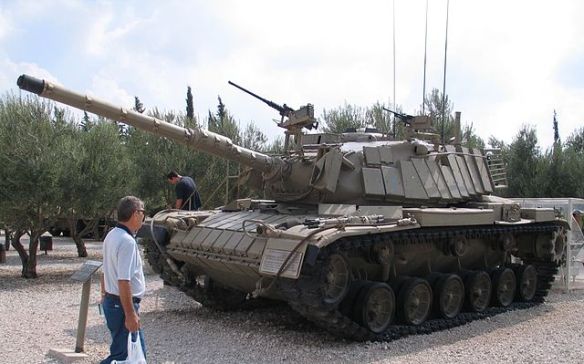M60A1 Patton tank with Israeli Blazer ERA.
The advanced Kontakt-5 explosive reactive armour on this T-90S is arranged in pairs of plates, giving the turret its prominent triangular profile.
Explosive reactive armor (ERA) is a common form of add-on armor employed in many armored fighting vehicles (AFVs), such as tanks. AFVs utilize an armor casing to protect the crew and the machinery against strikes from enemy antitank weapons. The antitank weapons, in turn, work by piercing the armor and killing the crew or damaging hardware and software. ERA is only effective against chemical energy antiarmor weapons, such as high explosive antitank (HEAT) rounds. ERA is not effective against kinetic energy weapons, such as sabot rounds.
In the late 1970s the Israel Defense Forces (IDF) developed the new ERA technology to protect AFVs. The concept underlying ERA was accidently discovered in 1967-1968 by a German researcher, Manfred Held, who was then working in Israel. Held and his team conducted tests by firing shells at wrecked tanks left over from the 1967 Six-Day War. They noticed that tanks that still contained live ordnance exploded and that this explosion could disrupt the penetration of a shaped charge. This insight led to the manufacture of ERA.
ERA utilizes add-on protection modules, called tiles, made from thin metal plates layered around a sloped explosive sheath. The sheath explodes when it senses the impact of an explosive charge, such as a HEAT projectile. By creating its own explosion the HEAT warhead detonates prematurely, which prevents the plasma jet of molten metal from the shell penetrating into the crew compartment of the AFV. Explosive reactive armor is most effective against HEAT rounds. Once used, an ERA tile has to be replaced.
The early ERA models effectively defended tanks and other AFVs from single strikes. However, after they performed their task, the explosive sheath was spent, leaving the AFV vulnerable to another shell in the same location. More recent reactive armor uses a combination of energetic and passive materials to withstand multiple strikes. These modern designs employ smaller tiles and more complex shapes to offer optimal plate slopes to counter potential threats including missile warheads, exploding shells, and rocket-propelled grenades (RPGs).
In early 1991 technicians installed ERA on the nose and glacis plate of Challenger 1, the main battle tank of the British Army. Likewise, the U. S. Army Materiel Command applied reactive armor plates to the U. S. Marine Corps M60-series tanks. Since that time, modern AFVs such as the Abrams M-1A2, the British Challenger 1 and 2, and a variety of Russian tanks have all demonstrated excellent protection by using ERA.
New generations of antitank guided missiles continue to pose a threat. In addition, in urban combat such as that which occurred in the Iraq War after 2003, enemy infantry armed with RPGs fired from multiple directions at close range have the potential to overwhelm the target’s ERA. One downside to the use of ERA is the potential to harm nearby friendly troops. In times past, infantry soldiers commonly used tanks as a means of transport. They would even ride on the tanks as they entered combat. ERA-equipped tanks made this practice too dangerous.
During the 1991 Persian Gulf War, the Iraqi military fielded almost 6,000 main battle tanks ranging from the obsolete T-55 to the modern T-72. Iraqi tanks lacked ERA. The main Iraqi battle tank, the T-72, had reactive armor but not ERA.
Development of ERA technology has continued. Advanced versions of ERA were based on better understanding of the science associated with ERA systems, and they utilized lower masses of explosives. These considerations have had significant implications on the logistics, storage, and handling of AFVs and protection systems without a reduction in the protection levels. Future ERA models are likely to employ so-called smart armor concepts that will integrate sensors and microprocessors embedded into the armor. These devices will sense the location, type, velocity, and diameter of the projectile or jet and trigger smaller explosive elements precisely tailored to defeat a specific penetrator.
References Dunnigan, James F., and Austin Bay. From Shield to Storm: High-Tech Weapons, Military Strategy, and Coalition Warfare in the Persian Gulf. New York: William Morrow, 1992. Hutchison, Kevin Don. Operation Desert Shield/Desert Storm: Chronology and Fact Book. Westport, CT: Greenwood, 1995. Jane’s Armour and Artillery, 1990-1991. London: Jane’s Information Group, 1990. Jane’s Armour and Artillery, 2001-2002. London: Jane’s Information Group, 2001.
